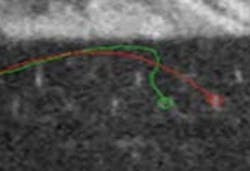DARPA's EXACTO program conducts first successful live-fire tests of .50-caliber optically guided bullets
Extreme Accuracy Tasked Ordnance (EXACTO) is a program conducted by the U.S. Defense Advanced Research Projects Agency (DARPA; Washington, DC); the intent is to develop guided .50-caliber bullets, using a combination of optical sighting technology and a steering system on each bullet. Now, DARPA revealed that the program, in its Phase II, has conducted successful live-fire tests (see video below).
(Video: DARPA)
The video shows a EXACTO round maneuvering in flight to hit a target offset from where the rifle is aimed. EXACTO’s steerable ammunition and real-time optical guidance system track and direct projectiles to their targets, and in the process compensate for weather, wind, target movement, and other factors that impede successful hits.
Technology development in Phase II included the design, integration and demonstration of aero-actuation controls, power sources, optical guidance systems, and sensors. The program's next phase includes a system-level live-fire test and technology refinement to enhance performance.
For more information on EXACTO, see http://www.darpa.mil/Our_Work/TTO/Programs/Extreme_Accuracy_Tasked_Ordnance_(EXACTO).aspx
The EXACTO technology is similar in some respects to a prototype laser-guided bullet system developed at Sandia National Laboratories (Albuquerque, NM) and demoed in 2012. In the Sandia system, which uses a large (4-in.-long) but narrow finned bullet, a laser-designated spot on the target provides the signal for the bullet to home in on.

John Wallace | Senior Technical Editor (1998-2022)
John Wallace was with Laser Focus World for nearly 25 years, retiring in late June 2022. He obtained a bachelor's degree in mechanical engineering and physics at Rutgers University and a master's in optical engineering at the University of Rochester. Before becoming an editor, John worked as an engineer at RCA, Exxon, Eastman Kodak, and GCA Corporation.
